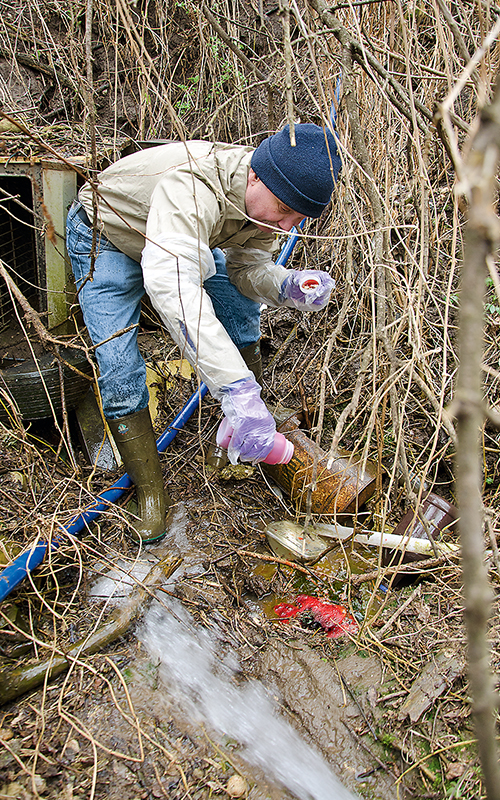Photo: MN DNR
The question of whether groundwater can be considered a point source under the federal Clean Water Act (CWA) continues to play out in courts across the country. In 2018, two federal courts of appeal ruled that it can.
Under the CWA, any discharge of a pollutant from a point source into a navigable interstate water is prohibited without a National Pollutant Discharge Elimination System (NPDES) permit. The “conduit theory” proposes that a pollutant from a point source that travels through groundwater (the “conduit”) into a navigable surface water requires an NPDES permit.
The Des Moines Water Works (DMWW) advanced this theory three years ago in a lawsuit against ten drainage districts in three counties in Iowa that manage agricultural drainage systems under state law. The DMWW sued over the discharge of nitrates from field tile lines (not traditionally treated as point sources under NPDES) into the Raccoon River, a navigable water supplying drinking water to the City of Des Moines. This burdened ratepayers with costly water treatment.
The federal district court in Board of Water Works v. Sac County Board of Supervisors (N.D. Iowa 2017) never decided the argument, as it dismissed the lawsuit on technical grounds. However, in this past year, two federal appeals courts did have the occasion to take it up.
"Fairly Traceable" Pollutants are Point Source Discharges
Photo: MN DNR
2018 saw the first review of this question in a U.S. Circuit Court, in the case Hawai’i Wildlife Fund v. County of Maui (9th Cir. 2018).
The case followed a flood of CWA suits filed by citizens across the country, all suits that relied on the conduit theory. Hawai’i Wildlife Fund brought its citizen suit against the County of Maui and alleged that the County’s disposal of more than 3 million gallons of treated wastewater into wells each day traveled through groundwater and into the Pacific Ocean without an NPDES permit, violating the CWA.
The federal appeals court found it to be clear that these wells constituted point sources, and that the effluent discharged from the wells was pollution under the CWA.
The issue in Hawai’i Wildlife Fund came down to whether a point source itself must convey pollutants directly into navigable water to be regulated under the CWA. The court decided that, because the flow of the non-NPDES-permitted polluted point source water was “fairly traceable” to the navigable water, a CWA violation had occurred.
In reaching this decision, the court determined that in forbidding the discharge of pollutants to navigable waters, the CWA does not require that the discharge directly flow to navigable waters. The court found that the County of Maui violated the CWA because (1) the County discharged pollutants from a point source, (2) the pollutants were “fairly traceable” from the point source wells to a navigable water, such that the discharge was the functional equivalent of a discharge into a navigable water, and (3) the pollutant levels reaching the navigable water were more than trivial.
EPA's New Rule to Clarify CWA Regulation Limits
Photo: MN DNR
Following this ruling, the EPA requested comments on a new rule (not yet promulgated) to clarify whether pollutant discharges from point sources that reach navigable waters via groundwater or other subsurface flow with a “direct hydrological connection” may be subject to CWA regulation. (The court in the Hawai’i case declined to consider a proposal in a brief submitted by the EPA that a liability rule be adopted requiring a direct hydrological connection between the point source and navigable water.)
"Direct Hydrological Connection" Required
Photo: MN DNR
Recently, another U.S. Court of Appeals followed the same line of reasoning as the Hawai’i case. In Upstate Forever v. Kinder Morgan Energy Partners (4th Cir. 2018), the court found an ongoing violation of the CWA where an underground oil pipeline burst, contaminating nearby groundwater.
The oil company fixed the pipeline, stopping the “continuous” release of oil into groundwater. However, the court determined that the pollution traveling through the groundwater and seeping into nearby surface waters, even months later, was an “ongoing” violation of the CWA, which does not require a “direct” discharge from a point source into a navigable water. This court, unlike in Hawai’i, required a “direct hydrological connection” – a higher standard than “fairly traceable” – between the point source and the navigable water to find a CWA violation.
Whether in agricultural, pipeline, or wastewater treatment settings, the role of groundwater as a conduit will continue to be an important issue under the CWA.



